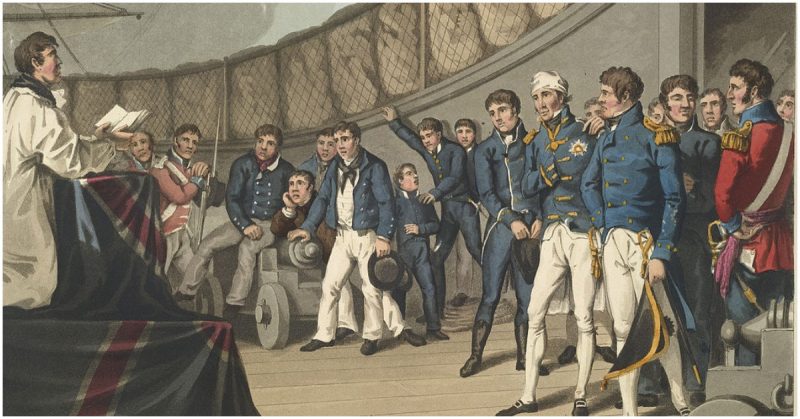The overwhelming danger to British seamen was not enemy action (this accounts for only 6.3% of those who perished at sea), but rather disease and accidents (over 81%).
Nelson’s flagship HMS Victory had a complement of 821 men that needed to react with precision to adjust the ship’s 37 sails, fire its 104 cannons, steer its 3,500 ton frame, and navigate by means of astronomical instruments. This required an intricate system of routine and discipline.
Organization
Sailors usually had no say in what ship they served aboard. While most were volunteers and served for patriotic or personal reasons, a good number were also pressed into service, especially as the Napoleonic Wars heated up and there was a great demand for men.
In 1793, there were 15,000 men in the Royal Navy; by 1813, there were 150,000.
Hierarchy aboard a man of war was as embedded as the continents to the Earth’s crust. At the top, commissioned officers lorded over all below, with the chief monarch being the captain.
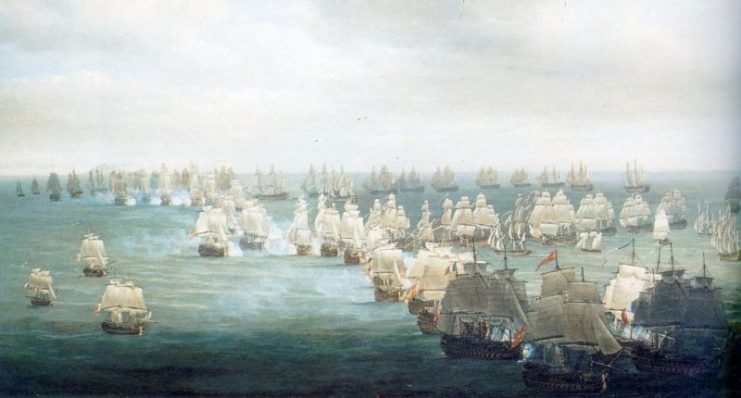
Next in line were warrant officers and petty officers. The petty officers were directly in charge of the seamen. The seamen in turn were divided into four classes: able, ordinary, landmen, and boys. Each man was allocated to a department with specific functions such as gunnery, sailmaking, and carpentry.
Most crew were allocated to the guns in teams of up to fourteen men. Others tended the sails and a good number worked as servants for the officers, or as messengers between parts of the ship. There were almost endless tasks to which crew members could be assigned.
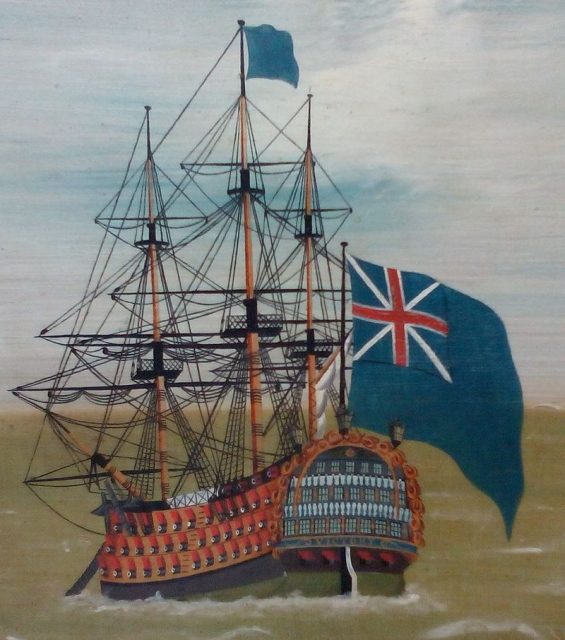
Somewhat outside the system was the large contingent of Royal Marines, equating in large ships to roughly 15% of the crew. Their job was to serve as sharp shooters, boarders, and soldiers in cutting out expeditions. Their other jobs included suppressing mutinies and standing guard during punishments.
To run the ship, the men worked in watches. The first lieutenant assigned watchbills and quarterbills to the men. Typically, captains ran a two-watch system with the day divided into starboard and larboard watches.
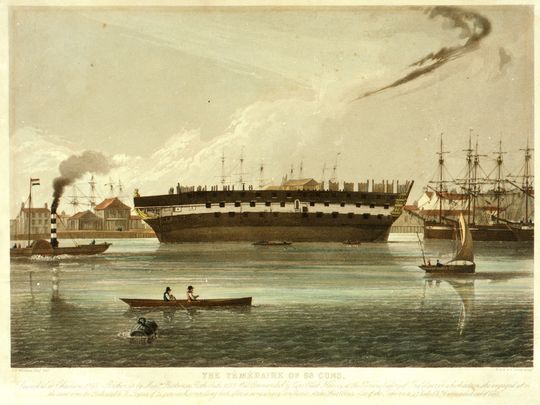
Date 1838
The 12-hour period of a starboard and larboard watch was subdivided into five, 4-hour watches and two, 2-hour watches (called dog watches). This allowed men to get increments of 4 hours of rest. The dog watches were established to create an odd number of watches per day so that every day a sailor’s watchbill would change, plus it allowed for efficiency at meal times.
Time was tracked by a half-hour glass that when emptied, would signal a crew to ring a bell to indicate the time. Some rare ships used a three-watch system which allowed the crew to get a full 8-hour rest period. This type of system was very popular among the crew.
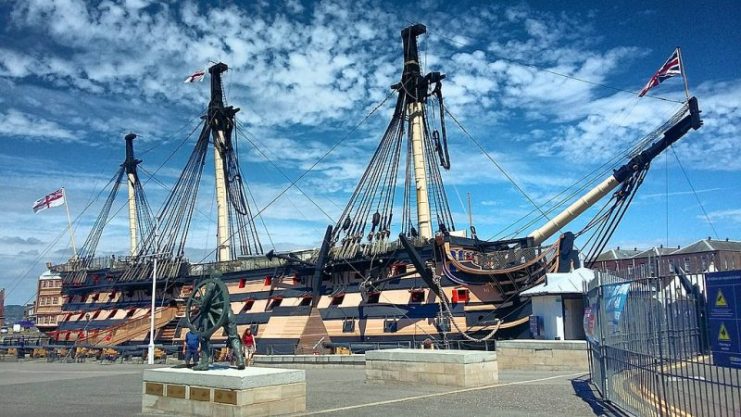
Pay
Pay was doled out once per lunar month. In 1815, the lowest paid were the inexperienced “landmen” at £1.2.6 on a first-rate vessel. As a sailor gained experience, he was rated up. An ordinary seaman earned £1.5.6 and an able seaman made £1.13.6. Specialists such as a sailmaker made more at £2.5.6.
For comparison, a lieutenant of a first-rate ship of the line made £8.8.0 and the captain earned £32.4.6. Keep in mind that pay was deducted for clothing and other items. Pay was also subject to variables such as length of service and on what class of ship the sailor was serving.
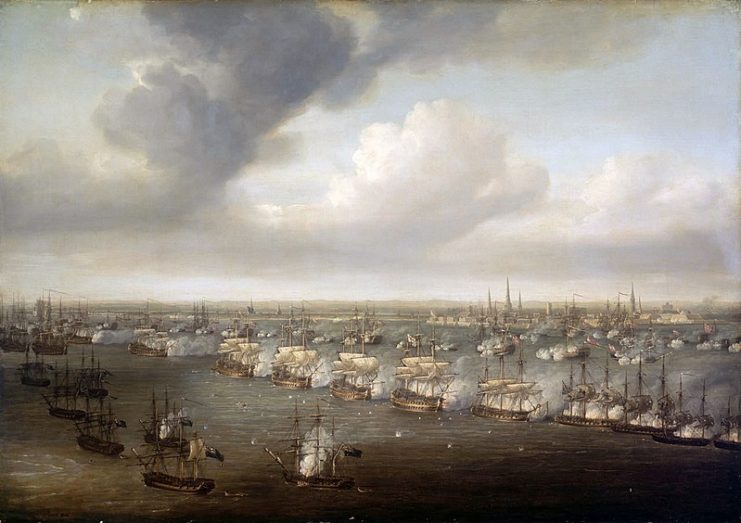
Uniforms
Compared to the elaborately uniformed officers or the red-coated Royal Marines, sailors had none. The usual kit was a short jacket, loose trousers, and a head covering (often with a ribbon that had the ship’s name written on it).
If there was any uniformity among sailor dress, it was due to the insistence of the captain or because the purser was purchasing the same type of clothing in bulk.
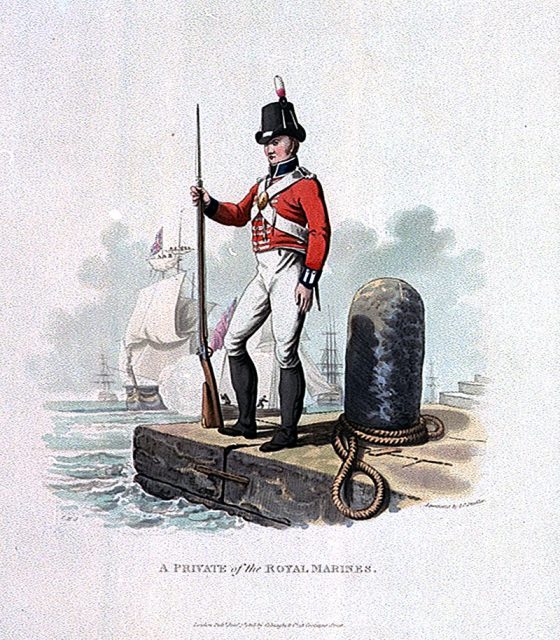
Below Decks
Sailors and petty officers berthed in the lower decks. There was little light here, and burning flame was highly restricted due to the dangers of fire. There was no privacy. Sea chests were shared.
Each man was given a 6-foot by 3-foot hammock, and hammocks were attached with hooks in a layout devised by the first lieutenant. Each sailor had 14 inches width of space to sleep. Petty officers, as a benefit of promotion, were given 28 inches. Sailors did not sleep directly on the hammock; rather, it served as a cradle for bedding which was bought through the purser.
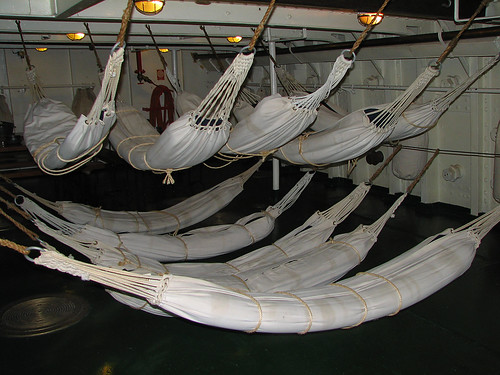
Due to a crowd of hundreds of unwashed men (many of whom suffered from seasickness) in a cramped and unventilated space, the lower decks reeked and were a breeding ground for disease. To improve conditions, hammocks were rolled up and stowed daily on deck when the weather was fine. Some ships even used manual or sail-operated pumps to ventilate the air below. But these efforts had limited impact.
One positive of having so many bodies crammed below decks was that on a cold weather cruise, no heating was required. This, of course, was negative in the tropics.
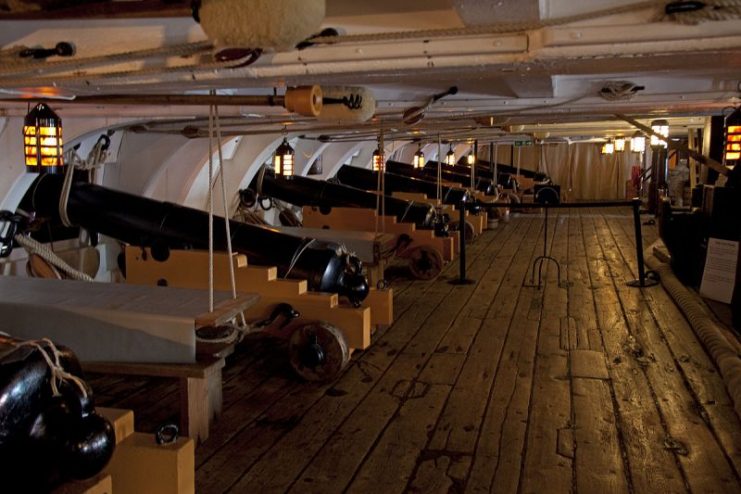
Tony Hisgett Date 3 May 2011,
In order to escape the discomforts of the lower deck, some mates and sailors slung their hammocks in the orlop deck, the lowest deck in the vessel. The drawback was that this area was where rats tended to make their home.
The overwhelming danger to British seamen was not enemy action (this accounts for only 6.3% of those who perished at sea), but rather disease and accidents (over 81%).
Accidents were prevalent due to low headroom, slippery decks, and the potential for exploding munitions or equipment mishaps during drills. Other sailors met their demise through foundering, ship-wide explosions, and fires.
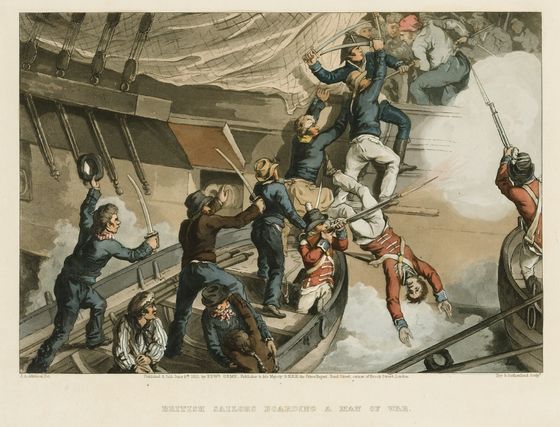
Food
Mealtimes for the crew were generally respected by the officers as sacrosanct in order to maintain morale. Forty-five minutes were allowed for breakfast and 90 minutes for dinner and supper. Dinner, eaten around midday, was considered to be the main meal.
Officers had the same rations as the crew, although they supplemented those rations with a mess subscription. Furthermore, meals for all were cooked in the galley using a large Admiralty-pattern stove.
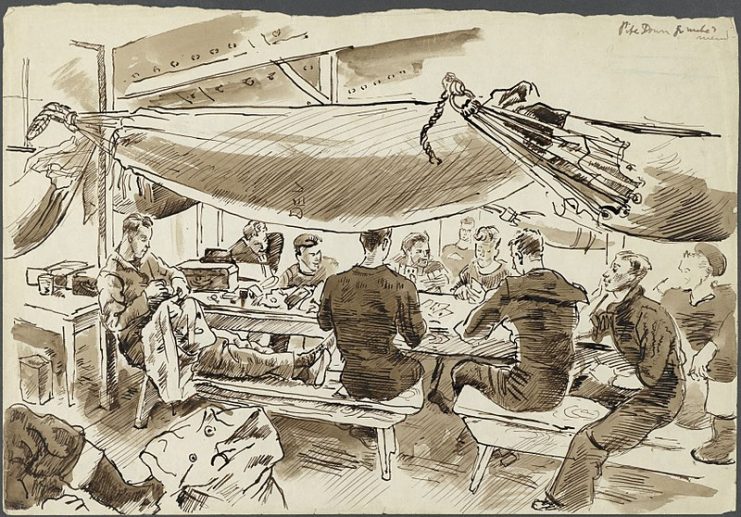
Cooks did not have to have culinary experience to be a ship’s cook. Until 1806 they just needed to be a Greenwich chest pensioner.
Meals were predictable. Meats (typically boiled and salted pork or beef) were served from Sunday to Tuesday and also Thursday. Oatmeal and sugar, butter and cheese were common food items. Each man had a one-gallon ration of small beer with low alcohol content, which provided needed calories for their very physical jobs.
A typical meal was lobscouse, which was salted and boiled meat, onions, and pepper that was combined with ship’s biscuit. This mixture was then stewed. A half pint of wine or a pint of grog would wash it down.

The ship supplemented this diet by carrying its own livestock. Bumboats rushed at a ship when it entered a port, selling badly needed fresh produce.
In addition, seamen would fish, catching sharks, skates, dolphins, and turtles. Birds were shot and eaten as well. Rats were hunted for sport and eaten, which were compared by seamen to the taste of rabbit.
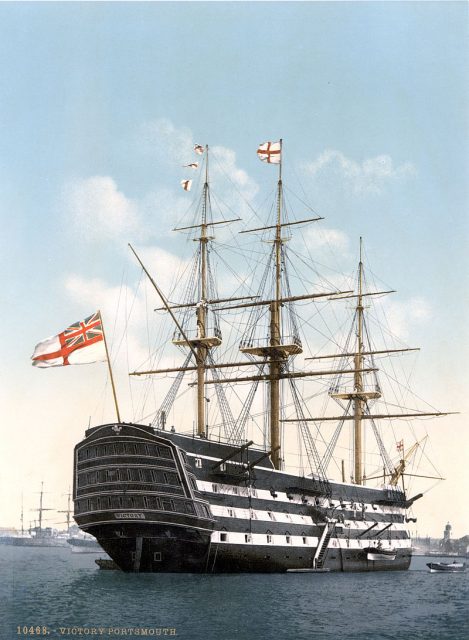
Discipline
To maintain order, strict discipline was employed. The Articles of War were read at the commissioning of the ship and once a month thereafter. These laid out the regulations for a crew’s behavior.
In 1757 there were 35 articles, and any disciplinary infractions not specifically named in the first 34 were covered by number 35—which gave the captain leeway to punish seamen “by the laws and customs in such cases used at sea.”
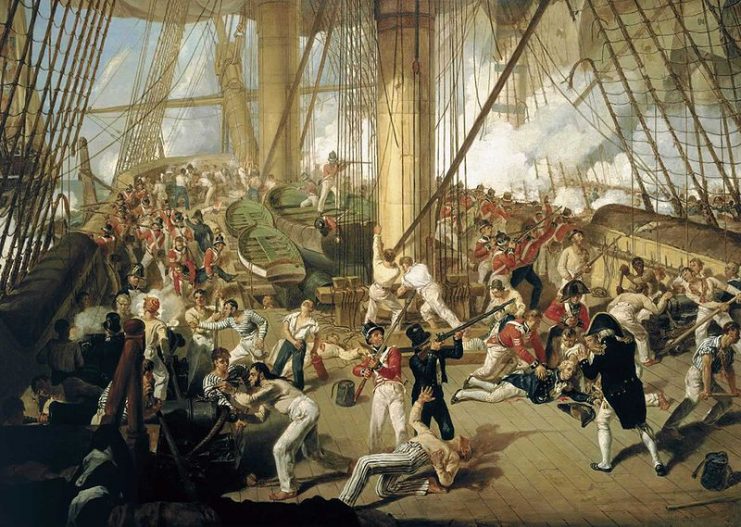
The methods of punishment were diverse. An officer or petty officer could hit a seaman with a cane called a “starter.” Victims could be tied spread-eagled to the shrouds for periods of time.
Read another story from us: “I See No Ships” Facts You May Not Have Known About Horatio Nelson
Serious offenses were dealt with by the captain, with the very worst going to court-martial in which a man would be tried by a group of officers. Punishments might be disrating a seaman, stopping their grog, or flogging (the maximum was 12 lashes but this was ignored by some).
In some cases, a sailor might be “flogged around the fleet” which was to have the punished man rowed to every ship in the harbor and flogged on each vessel. Then there was the ultimate punishment, hanging.
Despite all the travails of being a Nelsonian-era sailor, there is a romantic element to the life which is beyond all logic. I am sure, however, after a few months below decks, that one’s mind might change.
Grog, anyone?
